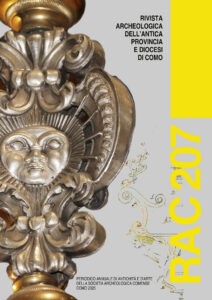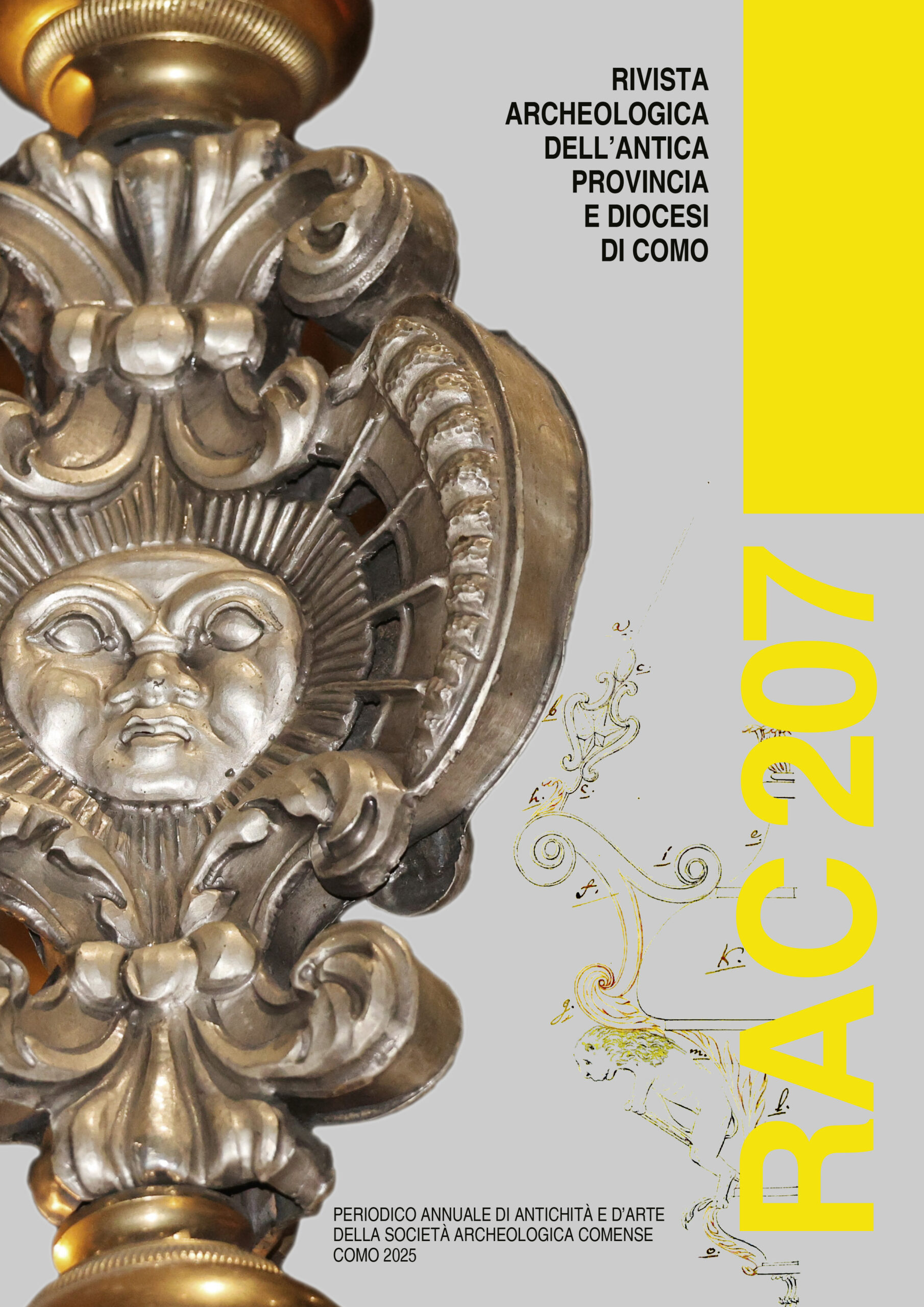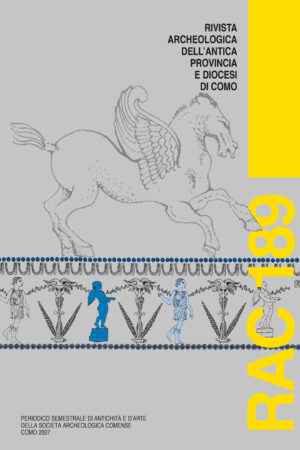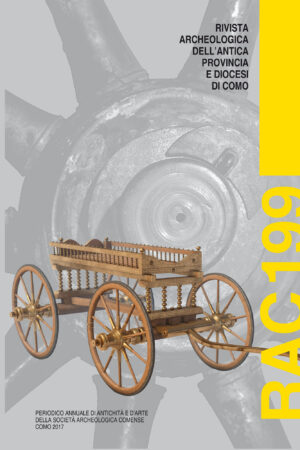Descrizione

S. Jorio, W. Basile, F. Butti, D. Massara, C. Pagani, F. Slavazzi
La villa romana di via Zezio, a Como
pp. 5-66
RIASSUNTO
La villa romana di via Zezio, situata in una posizione molto amena, si disponeva scenograficamente a terrazze sulle pendici del colle di Brunate, all’esterno della città di Como. Avrebbe potuto estendersi per una superficie di 7000 m2. A nord si sviluppava una strada glareata. Fu distrutta quasi completamente negli anni 1975-76, ma, nonostante questo, è la residenza di pregio sul Lario che meglio conosciamo.
Nel presente articolo vengono riconsiderate le strutture venute alla luce e vengono pubblicati per la prima volta tutti i materiali recuperati.
Si propone una nuova interpretazione per il “portico”, che si sviluppava per almeno 38 m circa, e potrebbe invece essere un ninfeo; forse esisteva anche un ambiente destinato al culto domestico, da cui proviene una piccola statua in bronzo di Venere.
I materiali rinvenuti sono molto pochi; in particolare ricordiamo alcuni elementi di pregio: una testa di menade in marmo, un frammento pregevole di sectile che rappresenta probabilmente un animale feroce, frammenti di intonaco affrescati con un motivo a candelabro, moltissime tessere in vetro di mosaico, che comprendono prevalentemente il colore blu e le sue sfumature.
I pochi elementi indicano che la villa era di altissimo livello; non abbiamo indicazioni riguardo ai proprietari, che dovevano essere molto facoltosi e raffinati.
I frammenti di ceramica forniscono una preziosa indicazione riguardo alla durata della residenza, che si sviluppa per tutta l’età imperiale e finisce nel tardoantico, come si verifica solitamente per le ville romane.
ABSTRACT
The Roman villa in Via Zezio, situated in a very pleasant location, was scenically terraced on the slopes of the hill of Brunate, outside the city of Como. It could have extended over an area of 7000 m2. To the north, a glareata road developed. It was almost completely destroyed in the years 1975-76, but, despite this, it is the prestigious residence on the Lario that we know best.
In this article, the structures that have come to light are reconsidered and all the recovered materials are published for the first time.
A new interpretation is proposed for the “portico”, which was at least 38 m long, and could instead have been a nymphaeum; perhaps there was also a room for domestic worship, from which a small bronze statue of Venus comes.
Very few materials have been found; in particular, we would like to mention a few valuable elements: a head of menade in marble, a valuable fragment of sectile probably depicting a ferocious animal, fragments of plaster frescoed with a candelabro motif, and many glass mosaic tesserae, predominantly featuring the colour blue and its hues.
The few elements indicate that the villa was of a very high standard; we have no indication of the owners, who must have been very wealthy and refined.
The pottery sherds provide a valuable indication of the duration of the residence, which runs throughout the Imperial age and ends in Late Antiquity, as is usually the case for Roman villas.
Annalisa Rizzotto
Como, rinvenimenti lungo le mura
pp. 67-74
RIASSUNTO
Le assistenze archeologiche effettuate in comune di Como per la sostituzione della rete dell’acquedotto tra via Cattaneo-via Lucini e viale Varese in un periodo non continuativo tra novembre 2020 e settembre 2021 hanno permesso di portare in luce alcune strutture relative alle mura urbane. Nonostante si sia trattato di scavi di limitata ampiezza, è stato comunque possibile interpretare le strutture rinvenute in modo abbastanza verosimile grazie alla cartografia storica e alle conoscenze note sulle strutture difensive post medievali dell’abitato. Si tratta fondamentalmente di elementi relativi alle opere di fortificazione effettuate nel primo Cinquecento, in particolare le strutture più antiche documentate sono tutte ascrivibili a inizio 1504 e all’estate 1507, durante la quale le mura furono rinforzate mediante l’aggiunta di rivellini al castello e davanti alle principali porte della città, con funzione di fortificazione e protezione.
ABSTRACT
The archaeological assistance carried out in Como for the replacement of the acqueduct network among via Cattaneo, via Lucini, viale Varese from November 2020 to September 2021 have brought to light some structures relating to the city’s fortification works dated in the sixteenth century. Although the excavations were limited in size, it was still possible to interpret the structures found in a fairly plausible way thanks to historical cartography and the knowledge of the post-medieval defensive structures of the city. These are basically elements related to the fortification works carried out in the 16th century, in particular the oldest documented structures can all be traced back -early in 1504 and in summer 1507- when the walls were reinforced building ravelins in front of the main gates of the city, with fortification and protection functions.
Emiliano Garatti, Barbara Grassi, Mimosa Ravaglia
Carella di Eupilio: imponente struttura di età preistorica
pp. 75-82
RIASSUNTO
L’assistenza archeologica effettuata ad Eupilio, presso il cimitero situato in via Segantini nella frazione di Carella, ha permesso di individuare una struttura di notevole interesse, interpretabile come possente muro; le dimensioni del rinvenimento suggeriscono una funzione importante, forse addirittura un muraglione difensivo o di cinta. I materiali associati al rinvenimento sono databili tra l’età del Rame e la piena età del Bronzo.
ABSTRACT
The archaeological assistance carried out in Eupilio, near the cemetery in Segantini street in the hamlet of Carella, revealed a structure of considerable interest, which can be interpreted as a mighty wall; the discovery suggest an important function, perhaps even a defensive or surrounding wall. The associated materials can be dated between the Copper Age and the Bronze Age.
Emiliano Garatti
Galliano di Eupilio, via S. Vincenzo: sito pluristratificato
pp. 83-88
RIASSUNTO
L’indagine archeologica effettuata ad Eupilio (località Galliano) in via S. Vincenzo, nella prima metà del 2020, ha permesso di documentare un sito pluristratificato, caratterizzato da un suolo presumibilmente databile ad età preromana, un’imponente struttura di incerta definizione databile ad età romana ed alcune evidenze medievali, tra cui due tombe ad inumazione, una delle quali è stata indagata.
ABSTRACT
A multi-stratified site, with a soil presumably dating back to the pre-Roman age, an imposing structure from the Roman age and some medieval evidences, including two tombs, has been discovered during an archaeological investigation carried out in Eupilio (in the hamlet of Galliano) in S. Vincenzo street, in the first half of 2020.
Samuele Cambianica
Sarcofagi monolitici di età imperiale romana e tardoantica sul territorio del Canton Ticino
pp, 89-130
RIASSUNTO
Nel Ticino meridionale sono stati rinvenuti numerosi sarcofagi monolitici a cassa rettangolare liscia, cronologicamente ascrivibili al periodo tra la seconda metà del II e il VI sec. d.C. Si tratta di una produzione locale, in gneiss o granito, destinata alla collocazione nelle piccole e medie necropoli della regione. In epoche successive, questi monumenti sono stati nella maggior parte dei casi oggetto di riempiego utilitario, soprattutto come vasche di fontana e lavatoi.
ABSTRACT
In the southern part of the Canton Ticino (Switzerland), several monolithic sarcophagi, dating from the second half of the 2nd to the 6th century CE, have been preserved. These funerary monuments are locally produced from gneiss or granite and were originally placed in the small- and medium-sized grave fields of the region. A notable feature of these sarcophagi is also their later reuse, particularly as troughs for fountains and washboards.
Davide Roselli
Dal collezionismo privato alla pubblica fruizione: una divinità danzante da Casa Versace
pp. 131-142
RIASSUNTO
Come è noto, la produzione scultorea di età ellenistica si presenta come una materia magmatica e complessa rispetto alle precedenti sperimentazioni classiche e tardo-classiche, rispondendo sempre meno a rigidi tipi scultorei e mescolando in sé diverse tendenze e soggetti dalla forma sempre più ricercata; la “Statua Versace” in esame costituisce un chiaro esempio di questi indirizzi artistici. Nondimeno, le vicende giudiziarie che la videro protagonista, insieme alla ricca collezione di antichità appartenuta allo stilista Gianni Versace, offrono testimonianza di una delle più importanti raccolte private della Milano degli anni Novanta. Lo studio che segue offre una prima analisi formale, stilistica e tipologica della cosiddetta “Statua di Divinità femminile danzante o in volo”, rimasta ancora inedita dal punto di vista bibliografico.
ABSTRACT
As is well known, Hellenistic sculpture presents itself as a magmatic and complex subject compared to previous Classical and Late-Classical experiments, gradually deviating from rigid sculptural types and blending different tendencies and subjects of increasingly refined form; the Versace Statue under examination is a clear example of these artistic directions. Nonetheless, the legal events in which it was involved, togheter with the rich collection of antiquities that belonged to the designer Gianni Versace, testify to one of the most important private collections in Milan in the 1990s. The following study presents an first formal, stylistic and typological analysis of the so-called “Statua di Divinità femminile danzante o in volo”, whose bibliography has not been investigated yet.
Rita Pellegrini
La grande lampada pensile in argento donata dal marchese Giacomo Gallio alla Cattedrale di Como: realizzazione, furto, restauro
pp. 143-166
RIASSUNTO
Con il proprio testamento del 27 settembre 1683, il marchese Giacomo Gallio ordinò che venisse fatta fabbricare a sue spese una grande lampada in argento per la cappella dell’Assunta che era in fase di completamento all’interno della Cattedrale di Como. La lampada venne commissionata all’argentiere Ercole Amos Somigliana, il quale aveva già fabbricato sei candelieri e una croce per la stessa cappella. Nel 1698, anno di realizzazione della lampada, il Somigliana risiedeva a Milano, ma in seguito si trasferì con la propria attività a Como.
Nel 1833 la maggior parte dell’argento della lampada Gallio venne rubata ma, senza che si scoprisse il colpevole, fu quasi tutto ritrovato in cattive condizioni l’anno successivo, in un nascondiglio nel presbiterio della Cattedrale. Dopo vari ripensamenti, la lampada venne fatta restaurare dall’argentiere milanese Cristoforo Corbella su disegno dell’architetto Biagio Magistretti.
Lo studio si occupa di tali avvenimenti e delle modifiche che vennero apportate alla lampada Gallio, nonché delle lampade che, prima di essa, erano state fabbricate per la cappella e per la statua mariana.
ABSTRACT
In his will dated September 27, 1683, marquis Giacomo Gallio ordered the manufacture, at his own expense, of a large silver lamp for the chapel of the Assumption, which was then under construction within the Cathedral of Como. The lamp was commissioned to the silversmith Ercole Amos Somigliana, who had already crafted six candlestick and a cross for the same chapel. In 1698, the year in which the lamp was completed, Somigliana was residing in Milan, but he later moved his workshop to Como.
In 1833, most of the silver from the Gallio lamp was stolen. Although the culprit was never identified, nearly all of the stolen material was recovered the following year in poor condition, hidden in the presbytery of the Cathedral. After much deliberation, the lamp was eventually restored by the Milanese silversmith Cristoforo Corbella, following a design by the architect Biagio Magistretti.
This study examines these events and the modifications made to the Gallio lamp, as well as the lamps that had been crafted before it for the chapel and the Marian statue.
Aurora Fontana
Portare a scuola centocinquant’anni di ricerche archeologiche sul territorio: il Castelliere del Caslè di Ramponio Verna in un progetto didattico per una classe terza di Castiglione d’Intelvi
pp. 167-170
RIASSUNTO
Il saggio descrive un progetto didattico effettuato in una classe terza della Scuola Primaria di Castiglione D’Intelvi nell’anno scolastico 2022/2023 sullo studio della Preistoria partendo dai reperti rinvenuti sul territorio Intelvese. Dopo una prima fase di contestualizzazione a livello spaziale e temporale, i bambini hanno approfondito le conoscenze riguardo al Castelliere del Caslè di Ramponio Verna, risalente all’Età del Bronzo, attraverso la visione del video degli scavi archeologici effettuati dal 2004 al 2010, la lettura dell’articolo scritto dal Canonico Vincenzo Barelli sulla Rivista Archeologica Comense e la visita al sito. In conclusione, ci si è soffermati sull’importanza della tutela del Patrimonio Culturale.
ABSTRACT
The essay describes a teaching experience in a third grade of Castiglione D’Intelvi Primary School, during the 2022/2023 school year, focused on the study of the Prehistoric period through local history. Children improved their knowledge starting with activities about the territory, then they studied the discovery of the Castelliere del Caslè, dating back to the Bronze Age. During the lessons they saw Marina Uboldi’s video recorded in the course of the archaeological dig realized from 2004 to 2010, then they read Vincenzo Barelli’s article published on Rivista Archeologica Comense and, at the end, they visited the site. At last, children were guided to make reflections about the importance of protection of the cultural heritage.
Claudia Lambrugo, Fulvia Butti
Necrologio di Gemma Sena Chiesa
Paolo Rondini
Necrologio di Raffaella Poggiani Keller




